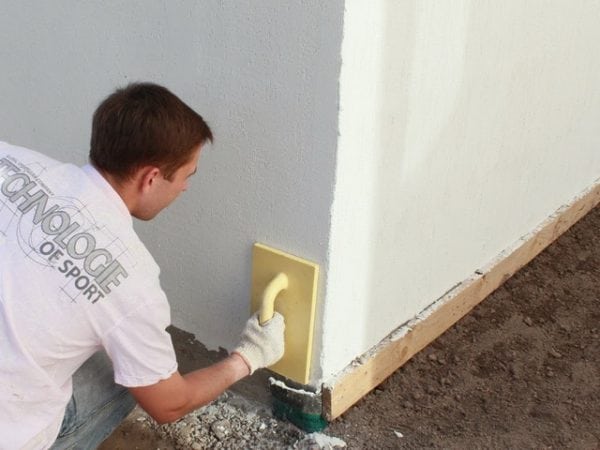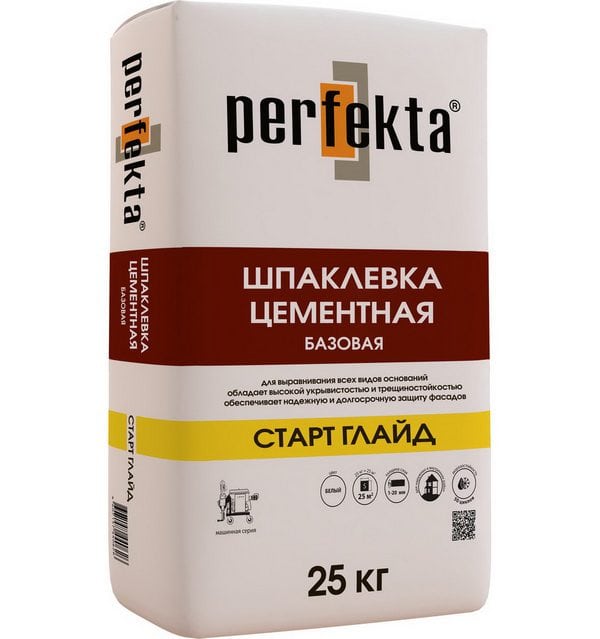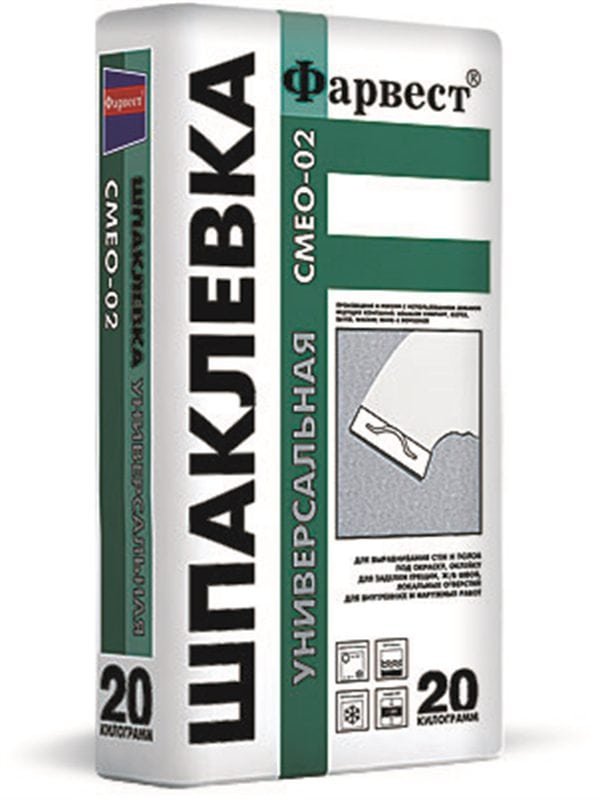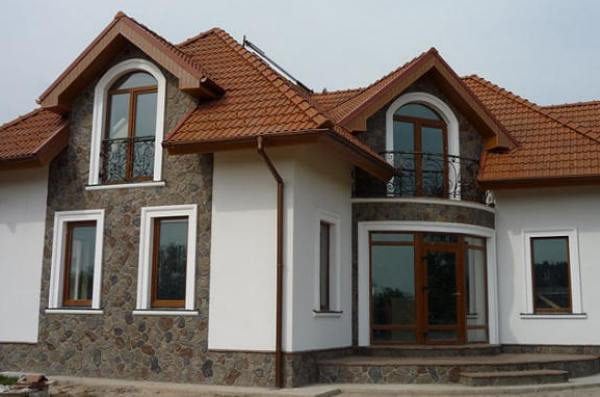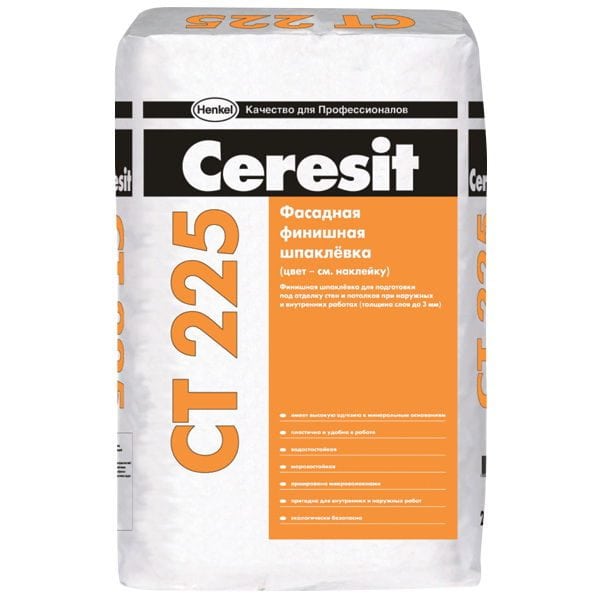To smooth the walls outside buildings or the surface of fences, puttying of surfaces is used. But on the street, where there are always large temperature differences and precipitation, ordinary leveling mixtures can be destroyed. This spoils the quality of the decorative finish. A special facade putty is needed here. But what are the parameters to choose a mixture for outdoor work?
- Finishing mix requirements
- Varieties depending on the purpose of the application
- Basic
- Finish line
- Universal
- Varieties of materials for the main component
- Mineral
- Acrylic
- Silicone and silicate
- Combined
- Features of puttying
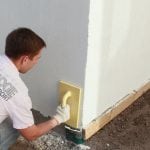
Finishing mix requirements
Due to the nature of the environment, the facade putty for outdoor work must meet the following requirements:
- Moisture resistance. Mists and other precipitation should not disturb the composition after solidification.
- Frost resistance. Winter frosts should not affect the strength of the hardened putty mortar.
- Elasticity. Temperature differences causing expansion and contraction, or shrinkage of the building should not destroy the putty for several seasons.
- Vapor permeability. This quality is not always respected, but if the putty mixture allows you to “breathe” the wall, this will prevent the destruction of the base and will allow moisture to be removed from the walls, which is formed due to temperature differences inside and outside the room.
- Possibility of tinting. In some cases, putty for the facade is applied as a decorative finish. Various color pigments are added to it for color.
- Consumption per 1 m2. It varies depending on the basis of the putty and on the structure of the wall. But in any case, it is recommended to focus on the ratio of price and expense. Expensive putties with a high consumption of 1 m2 are not profitable to buy, it is better to find a cheaper, but no less durable option.
- Finish compatibility. The mortar must be suitable for paint or tile glue.
- Solidification time. When working outdoors, there is always a risk of sudden deterioration in weather conditions, rainfall, so the solution should set as quickly as possible.
- Simplicity in work. Complex compositions that require special tools when applied, it is better not to acquire. Professional craftsmen recommend taking those that can be applied with a rubber spatula.
to contents ↑
Varieties depending on the purpose of the application
It is necessary to pay attention to the purpose of the composition for puttying.
Basic
It has a larger granular structure and is intended for the initial filling of large gaps, dents or restoration of chips. Color does not matter. Almost always, the base putty is facade gray or has a dirty white hue.
to contents ↑Finish line
The front finishing white mixture for puttying is more expensive, but it can be tinted and used as a decorative finish. If it is planned to paint a building or lay a tile as a topcoat, you can purchase a gray putty. Gray is not inferior to white in strength properties, and its color will still be hidden under the finishing materials.
Universal
Suitable for applying the base and finish layers, but can only be used on surfaces with small defects: when closing large cracks there will be a very large consumption of material.
to contents ↑It is important when buying to pay attention to the note: "For outdoor use." Compositions for working on the street can be used indoors, but those that are made for indoor use cannot be used for the facade because of their instability to atmospheric phenomena.
Varieties of materials for the main component
Mixtures for leveling surfaces are usually divided according to the main component. She may be:
- mineral (cement);
- acrylic;
- silicone or silicate;
- combined.
Mineral
It is made on the basis of Portland cement and is considered one of the most durable. The main feature of cement putty is that if it is exposed to moisture at the time of solidification, then its strength increases. Mineral formulations can be applied to a moist base and in wet weather.
Cement facade putty always has an unattractive appearance and needs additional decoration. In humid areas, it can be painted with mineral paint. In places where a moderate amount of moisture can be decorated with tiles or other decorative materials. Cement is universal in that almost any paint or glue can be combined with it.
The minus of the mineral finish is that it covers the wall with a dense layer, and the surface "does not breathe."
to contents ↑Acrylic
Acrylic is considered one of the universal putty mixtures and allows you to get a vapor-permeable coating for walls. There is also a minus - it is very inconvenient when closing large defects. Puttying the facade base is not very coarse, and when filling large defects, you will need to apply a lot of material, which means its consumption will increase.
Home craftsmen have found a way out of this situation. They do the following:
- apply the first layer of the finished acrylic putty and wait for it to dry;
- water acrylic varnish and gypsum powder are mixed until a viscous plastic composition is obtained and large irregularities are filled with it;
- smooth out minor surface damage.
This method is quite cheap and allows you to save material.
to contents ↑Silicone and silicate
The addition of silicone or silicate polymers gives the solution high strength properties. It is not difficult to work with polymer putties, but they are expensive, therefore they are used only under aggressive weather conditions (long rainy season, severe frosts).
Combined
Various combinations of the main components are possible here. But most often, a silicone or silicate polymer is added to an acrylic or mineral base to increase strength properties.
to contents ↑Features of puttying
Facade putty for exterior use is applied in exactly the same way as putty for interior use. To do this, you need:
- It is good to clear a surface of old decorative furnish. Traces of old paint, glue or lime will deteriorate adhesion, and the repair will be short-lived. For cleaning, you can use any tool. No need to be afraid to damage or scratch the base: with the help of putty all defects will be hidden.
- To wash. If the internal walls can be washed by hand, then it is recommended to use a car wash to wash buildings, especially since this unit is quite accessible and is available for many motorists.The water jet produced by a car wash under pressure will provide a more complete cleaning of all contaminants.
- To dry. On wet surfaces only mineral solutions are allowed. For all others, moisture is unacceptable - it will disrupt adhesion to the base and make drying putty uneven.
- Primer. Soil is recommended to select a composition close to the putty mortar. Primer application is necessary to improve adhesion.
- After the soil has dried, apply a base coat of putty and wait for it to set. If there are still large irregularities, then primer, dry and correct the surface with the base mixture in problem areas. This can be done with a rubber spatula or a paint brush.
- After correction, apply the primer again. Regardless of how many putty layers are applied, each of them must be primed to increase adhesion.
- After hiding large defects, a finishing layer is applied, having a finer grain size, and after it dries, you can proceed to the decorative finish.
If finishing is not planned after puttying and a solution with tinting is applied, then 2-3 layers should be applied, not forgetting the primer. The primer should be chosen transparent or take white and tinted to the desired color.
Putty can be applied with a rubber spatula, brush or roller. Using a spray gun is impossible: a viscous mass will quickly clog the nozzle. The spray gun can be used only when applying the primer and when finishing painting.
Puttying compounds for the facade is easy to apply, but the choice of their foundation must be approached carefully, taking into account local weather conditions. Only a correctly selected mixture will ensure the longevity of the repair and protect the walls from destruction.

